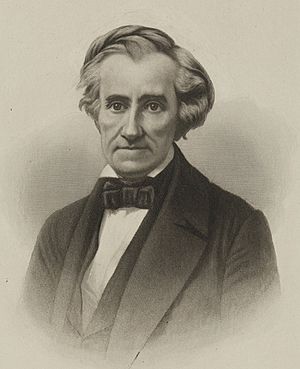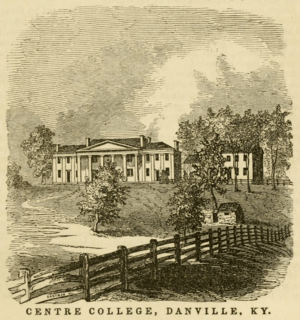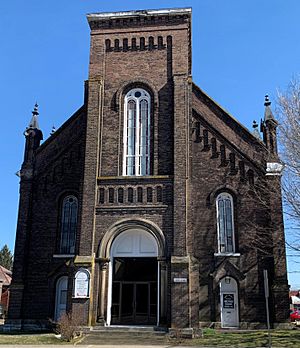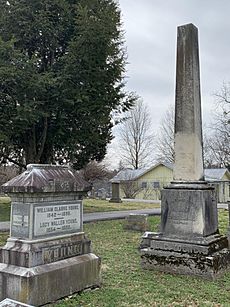John C. Young (college president) facts for kids
Quick facts for kids
John C. Young
|
|
|---|---|

Portrait by John Sartain
|
|
| 4th President of Centre College | |
| In office November 18, 1830 – June 23, 1857 |
|
| Preceded by | Gideon Blackburn |
| Succeeded by | Lewis W. Green |
| Personal details | |
| Born | August 12, 1803 Greencastle, Pennsylvania, US |
| Died | June 23, 1857 (aged 53) Danville, Kentucky, US |
| Resting place | Bellevue Cemetery, Danville, Kentucky |
| Spouses |
Frances Breckinridge
(m. 1829; died 1837)Cornelia Crittendon
(m. 1839) |
| Children | 10, including William |
| Education | Columbia College Dickinson College (1823) Princeton Theological Seminary (1828) |
| Signature | |
John Clarke Young (born August 12, 1803 – died June 23, 1857) was an important American educator and church leader. He served as the fourth president of Centre College in Danville, Kentucky.
Young studied at Dickinson College and Princeton Theological Seminary. He became a pastor in Lexington, Kentucky, in 1828. In 1830, he became the president of Centre College. He held this job until he passed away in 1857. This made him the longest-serving president in the college's history.
Many people think he was one of Centre College's best presidents. He helped the college grow a lot. He increased its money by more than five times. The number of students graduating also grew from two in his first year to forty-three in his last year.
While he was president, he also continued to preach. He became the pastor of the Danville Presbyterian Church in 1834. Later, he started the Second Presbyterian Church in Danville in 1852. Young was a respected church member. He was chosen as a leader for the Presbyterian Church's main meeting in 1853.
Today, parts of Centre College are named after him. Young Hall is named for him and his son, William C. Young. His son later became the college's eighth president.
Contents
Early Life and Education
John C. Young was born on August 12, 1803. His birthplace was Greencastle, Pennsylvania. His father, also named John Young, was a Presbyterian pastor. His mother was Mary Clarke Young. He was the youngest child and his parents' only son.
Young's father died when John was a baby. So, his mother and grandfather, George Clark, mostly raised him. He learned at home from his grandfather.
Later, he moved to New York City to attend a special school. After that, he went to college. His uncle, Matthew St. Clair Clarke, was a lawyer. He offered to teach Young about law. But Young chose to follow his father and become a minister instead.
Young first went to Columbia College (now Columbia University). He studied there for three years. Then, he moved to Dickinson College in Pennsylvania. He graduated with honors in 1823. After college, he taught math for two years.
In 1825, Young began studying to become a minister. He went to Princeton Theological Seminary. He spent three years learning about theology and how to understand the Bible. He also helped tutor students at Princeton University. He earned his degree in 1828.
Becoming a College President
John C. Young started his career as a minister in 1828. He moved to Lexington, Kentucky. There, he became the pastor of McChord Presbyterian Church. This church was started by James McChord. McChord was also the first president of Centre College.
In 1830, Centre College needed a new president. The college leaders looked for someone new. A professor from Princeton Theological Seminary suggested Young. The leaders voted for Young, and he accepted the job. He became the fourth president of Centre College on November 18, 1830. He was only 27 years old.
When Young took over, Centre College was struggling. Only about 25 students had graduated in its first eleven years. Young's main job was to raise money for the college. He traveled to New York and successfully raised $6,000. This money helped pay for two new professors. He also raised money from people in Danville and other parts of Kentucky.
Young also taught classes at the college. He taught logic and moral philosophy. He also taught other subjects when needed. He gave the graduation speech to the senior class in 1831.
Growing Centre College
During Young's time, Centre College taught many subjects. These included classics, mathematics, natural science, and history. All subjects were taught with a Christian focus. Each school day started with prayer. Students also had to attend religious lessons and sermons every week.
Young was also chosen to be a member of the Beta Theta Pi fraternity. At that time, it was common for college leaders to join fraternities. Many important people graduated from Centre College while Young was president. These included John Y. Brown and John C. Breckinridge.
In 1834, Young became the pastor of the Danville Presbyterian Church. This church served both students and the town. Many people liked his sermons, and the church grew quickly.
The Presbyterian Church faced a big disagreement in 1837. It split into two groups. Young was part of the "Old School" group. This group believed in more traditional teachings. Because the church grew so much, Young started a second church in 1852. It was called the Second Presbyterian Church. This church helped make room for all the students who attended.
In 1853, Young went to a big meeting of the Presbyterian Church in Philadelphia. He was chosen as the "moderator," which means he led the meeting. People said he was very capable. At this meeting, Young and others asked for money to build a new seminary (a school for ministers) in Danville. This school, the Danville Theological Seminary, opened later that year.
Family Life and Legacy
Young married Frances Breckinridge in 1829. She was the sister of John C. Breckinridge, who later became Vice President of the United States. They had four daughters. Frances passed away in 1837.
In 1839, Young married Cornelia Crittenden. She was the daughter of Governor John J. Crittenden. They had six children together. One of their sons, William C. Young, also graduated from Centre College. He later became the college's eighth president.
John C. Young had poor health for several years. He passed away on June 23, 1857, at age 53. He was still the president of Centre College when he died. He was buried in Bellevue Cemetery in Danville. His son William was later buried next to him.
Young believed that slavery should end slowly, over time. He thought this was a more reasonable way to end it than stopping it all at once. He owned some enslaved people himself and set some of them free. He also supported a plan for former enslaved people to move to Africa. He gave speeches about these ideas.
Lasting Impact
John C. Young had a big impact on Centre College. Many things at the college are named after him today. Young Memorial Hall, named for both John and William, was built in 1909. It was the college's first building just for science. A new Young Hall was built in 1970 and has been updated since.
The John C. Young Scholars program at Centre College is also named after him. This program helps students do special research projects.
Young is remembered as one of Centre College's best presidents. During his nearly 27 years as president, the college's money grew a lot. The number of students also increased. His last graduating class in 1857 had 47 students. This was the largest class Centre College had ever seen at that time. Young's time as president is still the longest in Centre College's history.




